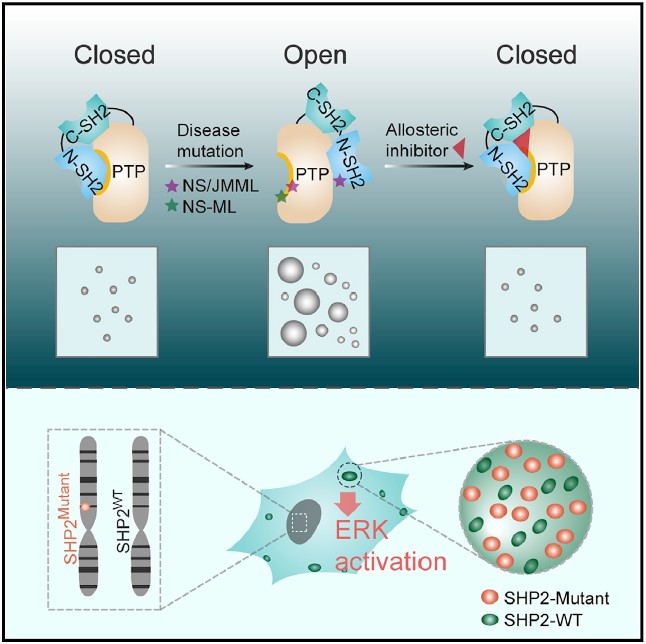

Noonan syndrome (NS) and Noonan syndrome with multiple lentigines (NS-ML) are rare human developmental disorders caused by mutations of the protein SHP2. Until recently, the mechanism of NS and NS-ML pathogenesis had been unclear, and nor was there any effective treatment for the disorders.
Now, however, researchers from the Shanghai Institute of Organic Chemistry (SIOC) of the Chinese Academy of Sciences have uncovered the mechanism that underlies the pathogenesis of NS and NS-ML.
They found that disease-associated SHP2 mutants acquire the capacity for liquid-liquid phase separation (LLPS) to boost enzymatic activity, leading to hyperactivation of the downstream cellular signaling pathway.
Phase separation has emerged as a fundamental mechanism that regulates various biological processes. However, very little is known about whether dysregulation of phase separation plays a role in human developmental disorders.
The team found that both NS and NS-ML mutations lead to gain-of-function LLPS of SHP2, explaining a long-standing puzzle as to why NS and NS-ML have similar clinical manifestations, although they have different SHP2 mutations.
According to the researchers, LLPS of SHP2 mutants is regulated by conformational changes in the SHP2 protein, and is potently inhibited by the SHP2 allosteric inhibitor ET070, which provides a therapeutic strategy of targeting SHP2 LLPS as a way of treating SHP2-associated developmental disorders.

Figure: Disease-associated SHP2 mutants acquire the capacity for liquid-liquid phase separation (LLPS) to boost enzymatic activity, thus leading to MAPK signaling pathway. [IMAGE: INTERDISCIPLINARY RESEARCH CENTER ON BIOLOGY AND CHEMISTRY SHANGHAI INSTITUTE OF ORGANIC CHEMISTRY]
This work also suggests the exciting possibility of using LLPS as a pharmaceutical target for developing new drugs.
The team believes that this study will offer new insights for understanding the link between LLPS and human disease, which will greatly help in the development of therapeutic approaches for treating disease. Their achievement in this regard was published entitled “Phase separation of disease-associated SHP2 mutants underlies MAPK hyperactivation” by Cell in its September issue of 2020.
For more information, please contact:
Zhu Jidong, Ph.D. and Professor
Email: zhujd@sioc.ac.cn
Interdisciplinary Research Center on Biology and Chemistry
Shanghai Institute of Organic Chemistry
Chinese Academy of Sciences
Source: Shanghai Institute of Organic Chemistry,
Chinese Academy of Sciences